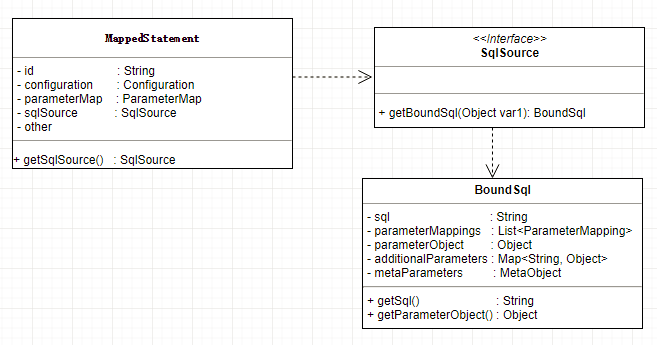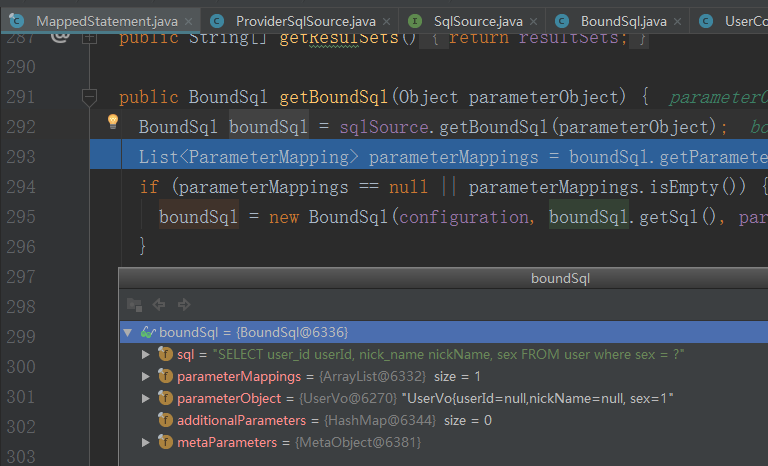上一篇文章介绍了MyBatis的Mapper接口是怎么运行的,在这篇文章中将简单介绍一下Mapper映射器的内部组成。
一般而言,一个映射器主要由3部分组成的:MappedStatement、SqlSource和BoundSql。
下面我们来了解一下这3类之间的关系,下图只列举了主要的属性和方法:

MappedStatement
它保存映射器的一个节点(select | insert | delete | update), 包括许多我们配置的 SQL、SQL的id、parameterType、resultType等重要的内容,例如:
1 | |
MappedStatement源码中的一些属性对应xml中元素的配置,详细的配置信息可以参考官网介绍, 代码如下:
1 | |
SqlSource
它是提供 BoundSql 对象的地方,是 MappedStatement 的一个属性。
接口源码如下:
1 | |
getBoundSql方法根据用户传递的parameterObject参数,动态地生成SQL语句并将信息封装到BoundSql对象中返回。其中paramenterObject为运行sql里的实际参数。
SqlSource有4个实现类

下面简单看一下其中一个实现类StaticSqlSource的源码:
1 | |
BoundSql
它是建立 SQL 和参数的地方。它有3个常用的属性:sql、parameterObject 和 parameterMappings。
源码如下:
1 | |
调用SqlSource的getBoundSql方法,生成BoundSql对象,里面就包含预编译后的SQL以及参数等数据。

参数传递
简单回顾一下Mapper接口的参数设置方式
1 | |
1 | |
当参数个数大于等于2时,我们通常使用@Param来给参数命名,然后在***Mapper.XML中通过参数名获取参数值。下面就来讲讲为什么要这么做。
上面我们说到,BoundSql有一个parameterObject属性,这个属性就是用来传递Mapper接口参数的。
下面我们看一下使用了@Param注解时的parameterObject的值

不使用@Param注解时的parameterObject的值

从上面parameterObject的调试信息可以看出,当有多个参数时,parameterObject使用HashMap来存储参数。使用了@Param注解,key值就是设置的参数名,否则就是arg0这样的形式。
属性介绍
BoundSql的3个主要属性及其作用
- parameterObject: 它为参数本身,有如下几个规则
- 传递简单对象时,如int类型,MyBatis会把参数变为其对应的包装类Integer对象传递。
- 传递POJO或者Map,那么parameterObject就是传入的类型。
- 传递多个参数,MyBatis会把parameterObject变成一个Map<String, Object>对象,键值与
@Param注解有关- 没用@Param注解,其键值是按顺序规划的,类似{“arg0”:p1, “arg1”:p2, “param1”:p1, “param2”:p2},所以我们可以使用#{param1}或者是#{arg0}去引用第1个参数。
- 使用@param注解,键值换成@param注解的键,如@Param(“key1”)String p1, @Param(“key2”)int p2, 键值为{“key1”: p1, “key2”: p2, “param1”: p1, “param2”: p2}。
-
parameterMappings: 它是一个List,每一个元素都是ParameterMapping的对象,这个对象会描述我们的参数。参数包括属性、名称、表达式、javaType、jdbcType、typeHandler等重要信息。通过它可以实现参数和SQL的结合,以便PreparedStatement能够通过它找到parameterObject对象的属性并设置参数,使得程序准确运行。
- sql: 就是我们书写在映射器里面的一条SQL。